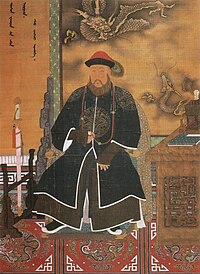This article needs additional citations for verification. (January 2013) |
| Dorgon | |||||||||||||
|---|---|---|---|---|---|---|---|---|---|---|---|---|---|
| Prince Rui of the First Rank | |||||||||||||
 Portrait of Dorgon as regent in imperial regalia | |||||||||||||
| Prince Regent of the Qing Empire | |||||||||||||
| Reign | 1643–1650 | ||||||||||||
| Co-Regents | Jirgalang (1643–1644) | ||||||||||||
| Assistant-Regents | Jirgalang (1644–1647) Dodo (1647–1649) | ||||||||||||
| Prince Rui of the First Rank | |||||||||||||
| Reign | 1636–1650 | ||||||||||||
| Predecessor | None | ||||||||||||
| Successor | Chunying | ||||||||||||
| Born | 17 November 1612 Yenden (present-day Xinbin Manchu Autonomous County, Fushun, Liaoning, China) | ||||||||||||
| Died | 31 December 1650 (aged 38) Kharahotun (present-day Chengde, Hebei, China) | ||||||||||||
| Consorts | Lady Borjigit Borjigit Batema (died 1650)Lady Tunggiya Lady Borjigit Lady Borjigit Lady Borjigit Princess Uisun | ||||||||||||
| Issue | Donggo | ||||||||||||
| |||||||||||||
| House | Aisin-Gioro | ||||||||||||
| Father | Nurhaci | ||||||||||||
| Mother | Empress Xiaoliewu | ||||||||||||
| Dorgon | |||||||
|---|---|---|---|---|---|---|---|
| Chinese name | |||||||
| Traditional Chinese | 多爾袞 | ||||||
| Simplified Chinese | 多尔衮 | ||||||
| |||||||
| Manchu script name | |||||||
| Manchu script | ᡩᠣᡵᡤᠣᠨ | ||||||
| Transcription name | |||||||
| Transcription | Dorgon | ||||||
Dorgon[note 1] 17 November 1612 – 31 December 1650), was a Manchu prince and regent of the early Qing dynasty. Born in the House of Aisin-Gioro as the 14th son of Nurhaci (the founder of the Later Jin dynasty, which was the predecessor of the Qing), Dorgon started his career in military campaigns against the Mongols, the Koreans, and the Ming dynasty during the reign of Hong Taiji (his eighth brother) who succeeded their father.
After Hong Taiji's death in 1643, he was involved in a power struggle against Hong Taiji's eldest son, Hooge, over the succession to the throne. Both of them eventually came to a compromise by backing out and letting Hong Taiji's ninth son, Fulin, become the emperor; Fulin was installed on the throne as the Shunzhi Emperor. Dorgon served as Prince-Regent from 1643 to 1650, throughout the Shunzhi Emperor's early reign. In 1645, he was given the honorary title "Emperor's Uncle and Prince-Regent" (皇叔父攝政王); the title was changed to "Emperor's Father and Prince-Regent" (皇父攝政王) in 1649.
Under Dorgon's regency, Qing forces occupied Beijing, the capital of the fallen Ming dynasty, and gradually conquered the rest of the Ming in a series of battles against Ming loyalists and other opposing forces around China. Dorgon also introduced the policy of forcing all Han Chinese men to shave the front of the heads and wear their hair in queues just like the Manchus. He died in 1650 during a hunting trip and was posthumously honoured as an emperor even though he was never an emperor during his lifetime. A year after Dorgon's death, however, the Shunzhi Emperor accused Dorgon of several crimes, stripped him of his titles, and ordered his remains to be exhumed and flogged in public. Dorgon was posthumously rehabilitated and restored of his honorary titles by the Qianlong Emperor in 1778.
Cite error: There are <ref group=note> tags on this page, but the references will not show without a {{reflist|group=note}} template (see the help page).